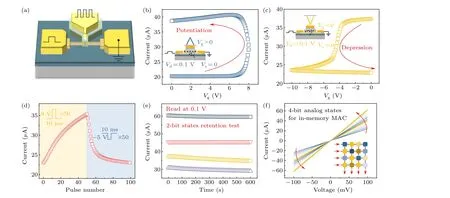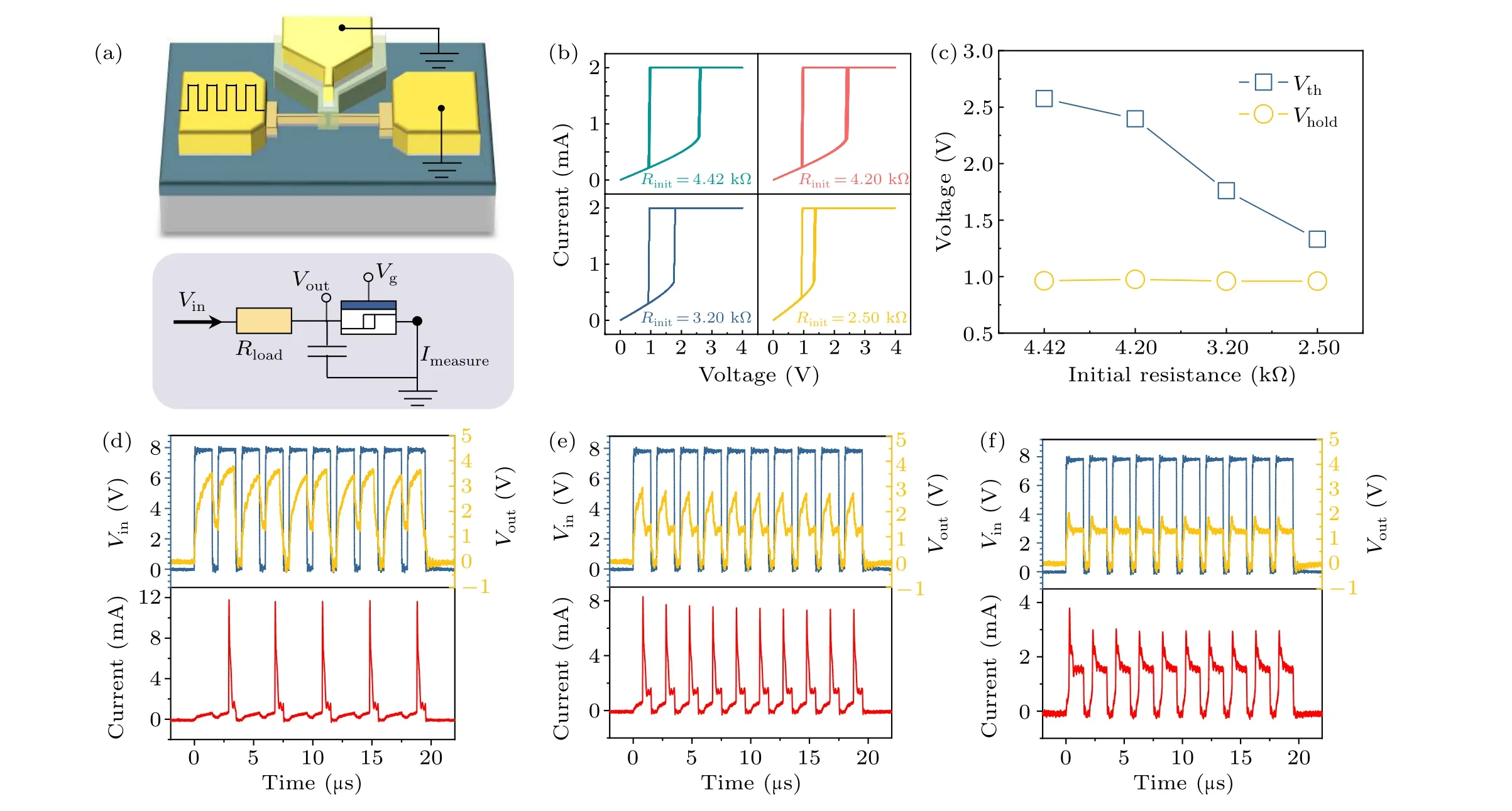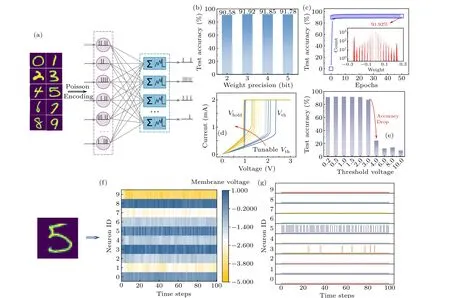Reconfigurable Mott electronics for homogeneous neuromorphic platform
2023-12-15ZhenYang杨振YingMingLu路英明andYuChaoYang杨玉超
Zhen Yang(杨振), Ying-Ming Lu(路英明), and Yu-Chao Yang(杨玉超),2,3,4,†
1Beijing Advanced Innovation Center for Integrated Circuit,School of Integrated Circuits,Peking University,Beijing 100871,China
2School of Electronic and Computer Engineering,Peking University,Shenzhen 518055,China
3Center for Brain Inspired Chips,Institute for Artificial Intelligence,Frontiers Science Center for Nano-optoelectronics,Peking University,Beijing 100871,China
4Center for Brain Inspired Intelligence,Chinese Institute for Brain Research(CIBR),Beijing 102206,China
Keywords: Mott electronics,reconfigurable,neuromorphic computing,VO2
1.Introduction
With the rapid developments of deep learning (DL),[1-3]the conventional hardware systems based on the CMOS circuits and von Neumann architecture suffered from severe delay and huge energy costs, especially when processing more huge volume of data.[4-7]To solve the problems, researchers start to learn from the human brain, which is better at processing complex cognitive issues with tiny energy costs.[8-10]These new computing paradigms are referred to as neuromorphic computing.[11,12]For instance, one important feature of computing in the brain is the integration of storage and processing, and lots of research has been devoted to constructing crossbar arrays based on emerging nonvolatile memories,which aim to accelerate multiplyaccumulate operations that dominated mostly in DL.[13-16]
The mostly studied artificial neural network (ANN) is a high level of abstraction of real neural networks in the human brain.To fully tap the potential of the brain, an SNN model was proposed,which has more similar structures to the brain than that of ANN.[17-20]Recently, there was some related hardware-accelertation of SNN or ANN.[21-27]The most obvious advantage of SNN is the ultra-low energy cost for the event-triggered characteristic.In the hardware implementation of SNN,the main components,synapses and neurons,are usually based on different materials and structures.The differenthardware based units will constrain the extension of network structures and functions.[28]Recently, there were some studies about reconfigurable neuromorphic devices for adaptive computing.[29-32]Through the same material system,the fabrication process of the neuromorphic systems can also be simplified.However,research on developing reconfigurable neuromorphic units for SNN is still scarce, and most of the existing approaches to reconfiguring still rely on extra electronic operations.[29,30]
Based on the above background and challenge, we designed a novel reconfigurable Mott device,which mainly consists of a VO2channel and LiPON electrolyte.The mechanism of channel resistance switching was clarified by material characterization and DFT calculations.Under the different operation modes,the EC-VO2device could be configured as synapses and tunable LIF neurons, the reconfiguration between different roles does not require any extra operations.At last,image classification was successfully implemented on the reconfigurable-EC-VO2-based platform.
2.Experimental detail
The studied EC-VO2device was fabricated on the Al2O3substrates.Firstly,40 nm VO2films were epitaxially grown by pulsed-laser deposition (PLD) technique; after that, 5 nm Ti and 25 nm Au were deposited on VO2films through electronbeam evaporation, in which electron-beam lithography was used for patterning.Then, the second electron-beam lithography process was carried out to pattern the active region,180 nm LiPON and 20 nm SiOxwere sequentially deposited by magnetron sputtering.After the lift-off process, 10 nm Ti and 220 nm Au were deposited using electron-beam evaporation to form testing pads.Finally, the three-terminal ECVO2device was completed after the last lift-off process.All the electrical measurements were performed using an Agilent B1500A semiconductor parameter analyzer.

Fig.2.Material characterization and DFT calculations of electrochemical doping.(a)Optical photograph of fabricated EC-VO2 device.(b)The cross-sectional TEM image of the active region in the EC-VO2 device, as indicated within the red box in panel (a).(c) Elemental mapping of different layers within the device through the red arrows in panel(b).(d)The initial conductance DC sweep of the EC-VO2 channel before LiPON deposition and after programming under positive gate voltages.(e)TOF-SIMS results of the EC-VO2 device after programming,in which the Li ions are intercalated into the VO2 layer.DFT calculations of the energy band structure of(f)pure M1 phase VO2 and(g)Li-doping VO2,which verifies the increase of electrical conductivity after ionic doping.
3.Results and discussion
The fabricated EC-VO2devices are shown in Fig.2(a),the gate pad is limited within the electrolyte region to avoid interferences with channel areas.The cross-sectional transmission electron microscope image of the device’s active region is presented in Fig.2(b),and the corresponding line scan of elemental mappings(Fig.2(c))verifies the material components.To form an amorphous LiPON fast ion conductor, we introduce nitrogen atoms into the initial lithium phosphate crystals,aiming to increase the reticular crosslinking structure.[32]To clarify the mechanisms of channel conductance modulation,material characterization with DFT calculation is employed to unveil that.As shown in Fig.2(d), the conductance of the programmed device increases 34 times more than the device without electrolyte capped,both active regions of devices are kept at 60 µm×60 µm.Time-of-flight secondary ion mass spectrometry (ToF-SIMS) characterization (Fig.2(e)) of the programmed EC-VO2device demonstrates the intercalation of Li ions into the VO2lattice.Given the small volume of Li ions,the doping positions are most probably at the interstitial sites.[33]The two material models are constructed in Figs.2(f)and 2(g).In Fig.2(f), the energy band structure of pure M1 phase VO2indicates a 0.6 eV gap, however, after introducing Li ions,the vanish of the band gap illustrated the increase of the electrical conductivity (Fig.2(g)).According to previous related research,[26]the introduction of Li ions can help weaken the binding strength between V ions and O ions,which can increase the concentration of free V3delectrons and overall carriers in the material systems.
3.1.Multi-tunable states for configuring as synapses
By utilizing dynamic ionic doping,the reversible channel conductance modulation can be realized,which can be configured as synapses in neural networks to implement in-memory computing.Figure 3(a) shows the typical testing schematics,the modulation signal in the gate terminal can control the doping or dedoping of Li ions in the VO2channel.As demonstrated in Figs.3(b)and 3(c),under the positive(or negative)gate voltage sweep,the channel conductance will get increased(or decreased) with Li ions moved into (or extracted from)the channel.The long-term potentiation and depression under continuous gate pulses are performed in Fig.3(d), the multi states can be employed to accelerate the matrix-vector product through Ohm’s law and Kirchhoff’s law.The retention tests in Fig.3(e)indicate the nonvolatile state changes under ionic doping,which can help hardware systems store the neural network weights even after the blackout.To realize full-analog computing,the linearity of different states under small reading bias is also tested in Fig.3(f),further proving the feasibility of EC-VO2configured as synaptic devices.

Fig.3.Electrical characteristics of EC-VO2 devices configured as synapses.(a) Typical testing schematics of synaptic properties, in which modulating signal is applied on the gate terminal and monitoring bias is applied on the drain terminal with source terminal grounded.The transfer curves of a(b)positive Vg sweep or(c)negative Vg sweep,with 0.1 V bias monitoring the channel conductance changes.(d)Long-term potentiation and depression under 50 pulses of 8 V and-5 V,whose widths are both set as 10 ms and monitoring read voltage is set at 0.1 V.(e) The retention performances of four distinguished states with a recording time of 600 s.(f) Linear-reading tests of 4-bit states for analog in-memory computation.
3.2.Tunable threshold-switching (TS) properties for configuring as neurons
There was plenty of research about utilizing VO2as LIF neurons,[34-36]so we can also change the role of EC-VO2from synapses to neurons.As shown in Fig.4(a),when testing ECVO2as neurons, the gate terminal and source terminal are both grounded, and the signals or connections with load resistors are placed at the drain terminal.Different from most of the previous two-terminal VO2devices, the third terminal can be used to modulate the channel resistances and further tune the TS behaviors.As demonstrated in Figs.4(b) and 4(c),the threshold voltage(Vth)will get reduced along with the lowering of initial channel resistances,while the hold voltage(Vhold)keeps still regardless of the initial states.Based on the previous research explaining the threshold-switching mechanisms, the insulator-metal transition (IMT) after the internal temperature reaches a critical point dominates.Ionic doping can only change the high-resistance states(HRS)before IMT while the low-resistance states(LRS)all keep almost the same at the conductive rutile phase.As the HRS decreases,to keep the heating power at the same level, the applied voltage will also be lower,which corresponds to the decrease ofVth;under the same LRS,theVholdwill keep almost unchanged when the heating power is below a certain level.The tunableVthprovides a more degree of freedom in designing the LIF neurons in neural networks.

Fig.4.Electrical characteristics of EC-VO2 devices configured as neurons.(a) Typical measurement schematics of testing neuronic properties, for which multi stimuli are applied at drain terminal with gate and source grounded.(b)Different I-V curves for different initial channel resistances,each state was tested 25 cycles and exhibited stable TS behaviors.(c) Average Vth and Vhold in panel (b) for corresponding initial resistance, which shows different relationships.The LIF neuron functions of different Vth at(d)3.6 V,(e)2.8 V and(f)1.9 V,with load resistance fixed at 4 kΩ.
The LIF neuron function tests of differentVthat 3.6 V,2.8 V and 1.9 V are shown in Figs.4(d),4(e)and 4(f),respectively.The following equation can describe the LIF neuron circuits:
whereCmis the capacitance in parallel to the VO2device or can be parasitic capacitance,Voutis the output voltage in Fig.4(a) or membrane voltage,Vinis the input voltage in Fig.4(a).RVO2represents the channel resistance of ECVO2andRLdenotes the load resistance of the LIF neuron circuits.When theVoutreaches beyondVth, theRVO2will change from HRS to LRS sharply, along with a sudden increase of current flowing from VO2, which is also termed as firing.From Figs.4(d)-4(f), the different firing frequencies and leaky-integrate behaviors result from differentVthand initial HRS,which can be adaptive to different realistic environments.
3.3.Large-scale SNN based on the reconfigurable Mott electronics
Based on the above discussions, we construct an SNN model based on the reconfigurable Mott electronics(Figs.1(b)and 5(a)), whose structure is set as a 748-10 fully connected network.The Poisson encoder is employed to encode the image intensities of Modified National Institute of Standards and Technology (MNIST) datasets to a set of spike trains, which follow the Poisson distribution.The subthreshold dynamics of output LIF neurons are defined as
whereVmdenotes the membrane voltage of the LIF neurons,Vrestrepresents the resting potential,τis the membrane time constant,andI(t)is the input to neurons at timet.When the membrane voltageVmexceeds the threshold voltageVth, the neuron will elicit a spike.Compared with the dynamic equation of the LIF neuron circuits based on VO2, the similarity enables direct hardware realization.To update the connected weights,the backpropagation through time(BPTT)and surrogate function are used to calculate the gradients.
When using the ECVO2as weights, the realistic state number needs to be considered (Figs.3(d) and 3(f)), so we adopt the symmetrically uniform quantized methods and differential cell structure, the Gaussian noises of 0.01 standard variation are also added into the quantized weights while keeping theVthat 1.0, the final testing accuracies of different weight precision are presented in Fig.5(b).When the weight precision exceeds 2 bits, the performances will reach saturation,and the state of EC-VO2can realize more than 16 distinguished states(4 bits),so it can easily meet the requirement of quantized weight precision.In Fig.5(c), the final testing accuracy of 3-bit precision can reach 91.92%,and the quantized weights also have an apparent boundary.In conventional twoterminal TS devices,the threshold voltage is usually fixed after fabrication, so it is hard to change theVthto realize devicealgorithm co-optimization in different situations.Based on our electrochemical modulation of the VO2parameters, theVthcan be tuned continuously by lowering the initial states(Fig.5(d)).The network performances of different threshold voltages and fixed 3-bit weight precision are demonstrated in Fig.5(e), which indicates the accuracies can be enhanced by setting the proper threshold voltage.Specifically,the threshold voltage value is different from theVthof EC-VO2,in which a linear scaling factor relates them,so in the realistic mapping of model parameters into hardware platforms, the scaling factor is worth carefully considering.
Finally, after finishing training the SNN in Fig.5(c), the number 5 is used to test the performances.As shown in Figs.5(f)and 5(g),the frequency of spike firing in neuron 5 is the maximum among all the output neurons,which proved the model realizes the successful classification.

Fig.5.The network-level performances based on the reconfigurable Mott electronics.(a)The network structure of the designed SNN,in which the Poisson encoder was employed to encode the MNIST images into a sequence of pulses.(b)The final test accuracies of different weight precision from 2 bits to 5 bits,with threshold voltage fixed at 1.0.(c)The evolution of test accuracy with training epochs,where the weight precision was chosen at 3 bits and threshold voltage was set at 1.0,the inset shows the final weight distribution after finishing the network training.(d)The measured multi I-V curves of different Vth,show the capacity of continuously modulating threshold voltages,which provide a more tunable parameter in enhancing the neural network performances.(e) The final testing accuracies of different defined threshold voltage in output neurons.(f) Testing results of classifying the number 5 after training in panel(c),both the evolution of(f)membrane voltages and(g)firing spikes with time steps can verify the successful classification.
4.Conclusion and perspectives
We propose and fabricate a kind of novel reconfigurable Mott electronics for constructing a homogeneous neuromorphic platform.By utilizing electrochemical ionic doping, the resistance of VO2can be reversibly modulated.On one hand,the nonvolatile resistance switching can be used as synapses to accelerate matrix-vector multiplication; on the other hand,the TS switching with electrochemical modulation can be configured as tunable LIF neurons.Based on the versatile ECVO2,a low-precision SNN model is developed,and combined with a properly designed threshold voltage, we successfully achieve high accuracy of image classification.Our work paves a new way for designing a homogeneous neuromorphic hardware platform to reduce process costs and enhance the flexibility of reconfiguration.
Acknowledgments
Project supported by the National Natural Science Foundation of China(Grant Nos.61925401,92064004,61927901,and 92164302) and the 111 Project (Grant No.B18001).Y.Y.acknowledges support from the Fok Ying-Tong Education Foundation and the Tencent Foundation through the XPLORER PRIZE.The authors acknowledge the support of TOF-SIMS characterization by Dr.Tinglu Song and the firstprincipal computation by Dr.Bing Zheng from Beijing Institute of Technology.
猜你喜欢
杂志排行
Chinese Physics B的其它文章
- Diamond growth in a high temperature and high pressure Fe-Ni-C-Si system: Effect of synthesis pressure
- Si-Ge based vertical tunnel field-effect transistor of junction-less structure with improved sensitivity using dielectric modulation for biosensing applications
- Speeding-up direct implicit particle-in-cell simulations in bounded plasma by obtaining future electric field through explicitly propulsion of particles
- Temperature-induced logical resonance in the Hodgkin-Huxley neuron
- Energy-distributable waterborne acoustic launcher for directional sensing
- Structural stability and ion migration of Li2MnO3 cathode material under high pressures
